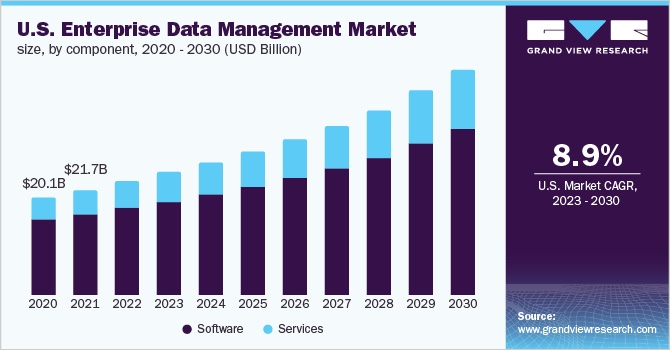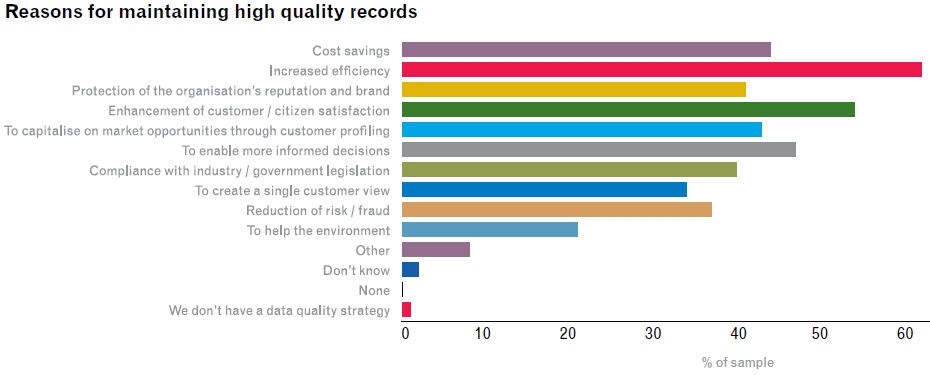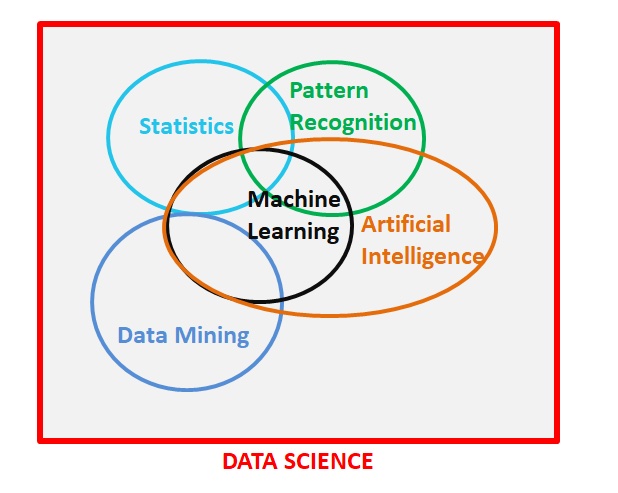Data is the lifeblood of your business. Every single day, you collect, generate, track, and analyze enormous amounts of data. In fact, the world generates a staggering 3.5 quintillion bytes of data every day (if you don’t know, a quintillion is a 1 followed by 18 zeros). That data comes in many different types, but you can use much of it to inform business decisions and to help your company grow and thrive.

Data Management Process: Ensuring Your Company Has Access to Accurate Data
The data you collect and manage encompasses many different types of information. From customer behavior while browsing your website to purchasing patterns over the previous months. This data can improve website usability as well as plan better marketing content.
However, with so much data being collected, what is your data management process? How do you focus on accurate data to help drive your business?
What is Data Management?

Image sourced from grandviewresearch.com
Data management refers to how your organization collects and stores all pertinent data, ensures it is secure, and then how you use it, including leveraging social media tools for data analysis and customer insights. Data management starts at the point of contact where you collect data; for example, when a customer fills out an online form with their contact details. As it is cyclical, it never really ends, but the last stage of the process is when you use that data to make business decisions.
As your data comprises many different types and formats, an efficient data management process also involves finding ways of integrating and analyzing that data to give you a solid foundation of BI (business intelligence) for strategic planning. Your data management should also include all the policies and tools that allow you to use that data efficiently while complying with any applicable laws and regulations.
Data can be crucial as you grow. It not only identifies areas of weakness and potential growth but can also dictate your content strategy and other business operations. With the importance of data in every aspect of your business, a data management plan is essential.
Why Is Data Management Important for Your Business?

Free to use image sourced from Unsplash
If data is the lifeblood of your business, then it makes sense that you want to ‘look after’ that data as well as you can. After all, if you don't, then the strategic decisions you make may be based on inaccurate or out-of-date information. With so much data generated daily—and so many different types—most businesses invest in good data storage and efficient management infrastructure.
They also look to data management systems to help sort that data and give them good business intelligence that helps with strategic decisions both in the short and long term. That BI comes from insightful analytics that drills down through raw data to give you hard facts about your business's performance and how customers interact with you.
Why is this so important, though? There are various benefits that can come from good data management processes.
Increased revenue and profitability
Good analytics can give you an accurate snapshot—both current and historical—of every area of your business. You can use those snapshots to make decisions that optimize your operational areas and reduce costs. For example, you could use data to create better CTAs that increase conversion rates.
You can also use the data for business forecasting; for example, you could look at historical buying patterns to buy products when needed, thus decreasing warehousing costs while increasing sales.
Additionally, leveraging coworking space analytics can provide insights into space utilization, occupancy trends, and member preferences, enabling coworking providers to make data-driven decisions that maximize profitability and enhance the overall coworking experience.
Compliance

Image sourced from econsultancy.com
Much of the data you handle daily is protected by strict laws and regulations that cover where you are based and the regions in which you operate. The main ones to be aware of are the GDPR (General Data Protection Regulation) in the EU, SOX requirements, and the CCPA (California Consumer Privacy Act) in California. Your data management process should ensure compliance with any relevant laws and should guarantee that your business does not:
- Collect your data without your consent.
- Store it unsafely or in locations where it is vulnerable.
- Retain your data even when you have requested you do not.
To effectively communicate and simplify these processes for stakeholders and team members, consider using visual representations such as infographics. If you create Infographics it can provide a clear and concise overview of the data management journey, making it easier for everyone to understand and participate in the process. They can visually depict the stages involved, the flow of data, and the key considerations at each step, enhancing comprehension and engagement.
Ensuring data consistency
Much of your raw data exists in silos that may only be accessible by certain teams or departments. This can reduce the quality and consistency of any data you analyze. An efficient data migration solution should integrate and centralize all your data so that any information you glean from analyses is accurate and gives you the information you want and need.
What Areas Should Your Data Management Process Focus On?
So, you can see that good data management is important, but what areas should any process focus on?
Quality management
If your data is low quality, then any strategic decisions you make will not be wholly accurate. Reliable and quality data means you can make informed decisions. Depending on the size of your organization, you may choose to appoint a data quality manager to oversee the process of ensuring you only have quality data.
This role is responsible for measuring the quality of your data and striving to improve it. They will look at and compare new data and existing or historical data and ensure that every step of the data management process gives you the level of information you want. They may also implement processes that ‘block’ low-quality data from entering your system. The standards they may include in the data quality process include the following:
- Ensuring that any data—and datasets—are complete and are not missing crucial information.
- Is all the data accurate? For example, has the customer entered all the correct details?
- Does the data already exist in your system? Do any duplicate entries contain the same information, or have there been changes? For example, a customer has changed their home address.
- Are the data formats consistent across your system? This could include information such as the customer’s date of birth.
Managing big data

Big data refers to large volumes of data you collect quickly but in a short time. A good example would be a video from social media that is relevant to your business. Because of the volume of this data, it can present complex challenges when it comes to managing and storing it.
Data management tools and processes that work with big data need to be able to process that data so you can analyze it. There are three primary functions you want to be able to perform; integration, storage, and analysis. If you need to manage big data, consider the following about your system.
- Is the data unstructured? This could include images and videos.
- If the data is structured, does it show in a tabular format?
- Is any of the data semi-structured? This could combine the previous two types of data.
Data distribution
Where do you plan on moving your data to and storing it for future use? Is your data storage in-house, or is it outsourced or cloud-based? Data can be distributed to different endpoints, including your operational systems or data warehouses/lakes. This distribution is crucial as, when you need to access data for operational reasons, network latencies may delay delivery.
Having copies of your data stored in other databases means you can access it when needed without experiencing any network latency issues. This allows you to access data whenever you need to without worrying about any issues. Different data structures, such as DataFrames (what are DataFrames?) or Resilient Distributed Dataset (what is RDD?), can help you access and organize your data efficiently.
Managing email lists plays a critical role in implementing targeted and personalized marketing campaigns. It encompasses various tasks such as maintaining up-to-date and accurate lists, segmenting subscribers based on specific criteria, and seamlessly integrating with Customer Relationship Management (CRM) systems.
Compliance with data protection regulations and obtaining proper permissions are fundamental aspects of effective email list management. By leveraging well-maintained email lists, businesses can enhance communication, increase engagement, and deliver tailored content to their audience.
In addition, ensuring the security and accuracy of your data is vital. Consider leveraging a doctor email database to enhance your data management process. Access to verified and updated email addresses of doctors can help you improve the outreach and communication with healthcare professionals, enabling targeted marketing campaigns and valuable collaborations.
Data consistency
Good distribution processes mean you can consolidate your data and ensure consistency. An organization will use a data warehouse to store data for analytics. In contrast, data lakes can be used as a consolidation hub from which you can extract data for different use cases. The mechanisms you use for distribution will have a major impact on the consistency of your data, something that is another priority in any data management process.
You need to be able to replicate your data synchronously so that if you change the value of any data, all connected applications and all users will see that new value. Without this replication, nobody can access that data until all copies are updated. Of course, you do not always need 100% consistency. For example, posts on social media and related comments or likes do not require high levels of consistency. But you do need consistency when it comes to factors such as customer information.
Modeling and architecture

Modeling
If you want efficient data management, then you need to create models that are both conceptual and logical. These should then allow you to visualize the various workflows and connections between different data types. You begin this by representing any data conceptually and then replicating it in the context of the technologies you use. A good data manager would likely create multiple models during the planning and design stage.
Architecture
Data architecture refers to all your data-related assets and gives you a plan for creating and managing your data flows. Any plan for data management should include all your technical details, including data lakes and warehouses, all operational databases, and connected servers. This architecture is fundamental to implementing any data management process.
Governance
You need good governance included in any data management process. This can include all your policies and procedures covering the security and integrity of your data. It should clearly identify who can access what data and define responsibility and who is accountable for use and access. The things you should incorporate in your governance policy include:
- Laws and regulations. If you fail to comply with any relevant laws and regulations, you could face a fine or other punishment. Compliance is essential, and good governance can reduce the risk by ensuring that all users are aware of the rules and receive relevant training.
- Security and controlled access. Your governance should also cover all security aspects and who can access any of your stored data. Tools such as Linux VNC can help with this. Not every employee needs access to data. For example, a manager will likely need access but janitorial staff will not. You should have a policy that also prevents accidental deletion or moving of data.
Another crucial aspect to consider in your data management process is database accessibility monitoring. It involves implementing mechanisms to track and monitor access to your databases, ensuring that only authorized individuals have appropriate access privileges. By implementing database accessibility monitoring tools or solutions, you can enhance data security, detect and prevent unauthorized access or breaches, and maintain data integrity throughout your organization's data management journey.
You also need to consider the risk of external cyber-attacks. This can entail ensuring the network and physical data centers are as secure as possible. Another risk to consider is access from personal devices; depending on the sensitivity of data, you may want to restrict such access.
When you have a list of authorized users, be sure to implement robust policies on authentication and authorizations, such as regular forced password changes. You should also keep users up to date on security risks and how to prevent them. Finally, be aware that your data may be stored in a different state or country, and you need to comply with any laws relevant to that location.
Data Management Challenges You Might Face

Free-to-use image sourced from Pixabay
Of course, it’s a complicated process that may encounter challenges along the way. Knowing the main challenges allows you to prepare for them arising.
Staff
Data management may be new to your business. That means you might have massive amounts of data and existing departmental silos. One of the biggest challenges you will face when implementing a data management process is to get the new process and associated systems accepted by all. Awareness and training sessions are the best way to get them onboard.
Compliance
Compliance with all relevant laws and regulations can be complicated at any time. However, as it is an integral part of good data management, you need to not only stay up to date with any changes but ensure that all users are aware of what regulations govern your organization’s use of data.
With the importance of data in every aspect of your business, a data management plan is essential. A virtual data room is a powerful tool that can aid in secure data storage, access, and collaboration, making it an ideal addition to your data management infrastructure.
Scalability
With the amount of data generated growing constantly, you need to be sure that your data management process is scalable so that it works well now and in the future. So, you should ensure that software, systems, and architecture are designed to cope with any increased demand.
Ensure Data Accuracy With Data Management Processes

The importance of your data cannot be emphasized enough. Without access to accurate data, your business would mostly be stumbling blindly in the dark. An efficient data management process helps ensure accuracy and assists in other crucial areas, such as security and compliance.
If you are just starting the data management journey, then careful planning is a must. Identify your business needs as well as any relevant laws and regulations so that you can plan one step at a time. This is not a process that should be rushed, and you should also keep a close eye on the potential changes your business will face in the future.